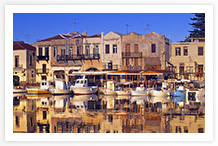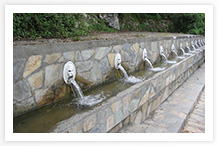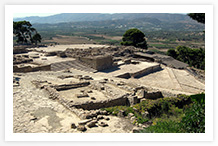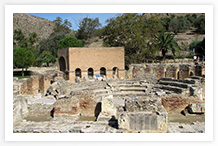Rethymno - Spili - Messara
The price is set only for departing from Heraklion city. For departures from other locations, please contact us for advising the price.
Points of Interest:
RETHYMNON (OLD TOWN)
 The old town of Rethymnon is one of the best-preserved towns of the Renaissance. Lying in the heart of modern Rethymnon, it combines the oriental features of the Turkish period with Renaissance-style Venetian architecture.
The old town of Rethymnon is one of the best-preserved towns of the Renaissance. Lying in the heart of modern Rethymnon, it combines the oriental features of the Turkish period with Renaissance-style Venetian architecture.
After the Venetian conquest of Crete (1204), the town of Rethymnon was built according to the rules of Venetian architecture. The original craftsmen were Venetians, but these later were replaced by Cretan murari, Venetian-trained master builders.
The layout of Rethymnon is directly linked to the sea, with the main Venetian street, the Ruga Maistra (today's coastal Venizelou Avenue) running parallel to the sea. The opposite is true of Heraklion and Hania, where the town is closed to the sea for reasons of defence and the main street is at right angles to the coast.
The private mansions of Rethymnon are not as impressive as those of Venice, mainly for financial reasons. Furthermore, the strong traditions of Cretan architecture could not be overcome, and Renaissance influences are most apparent on building facades.
Finally, as opposed to Heraklion and Hania, Greek features are predominant in Rethymnon because most nobles were Greeks, known as “Archondoromeoi” (noble “Romans”, that is, inhabitants of the Eastern Roman Empire).
Many buildings with gothic features were lost in the destruction of the town by Ulu Ali in 1571, while Rethymnon was rebuilt almost in its entirety in the third quarter of the 16th century. Many fine examples of Turkish architecture are preserved scattered around the narrow streets of the old town.
Their main feature is the heavy use of wood. Building styles changed during the years of the Turkish occupation (1646-1898) and the dressed stone of the Venetians was replaced by a wooden frame filled with rubble and mud (bagdati). The walls were then thickly plastered. The upper storey almost always projects out over the street (sahnisi) and is faced with wood, often with kafasoto latticework.
In Rethymnon the Turks made full use of the existing Venetian public and private buildings, which they modified according to their needs.
Today the old town of Rethymnon is a living museum of monuments of past centuries. Despite the damage sustained in the Second World War, many Venetian and Turkish monuments still stand, especially as the town has not been struck by major earthquakes.
Points of Interest:
SPILI
 Spili is a picturesque village located at an altitude of 430 metres, 28 kilometres south-east of Rethymno.
Spili is a picturesque village located at an altitude of 430 metres, 28 kilometres south-east of Rethymno.
Due to its altitude the village offers an astonishing view. It is surrounded by verdant vegetation and is filled with trees, fountains, springs and chapels and churches with wonderful murals.
The main square of the village is lovely and has a fine stone fountain constituted by a row of stone carved lion heads from where crystal-clear water flows.
The village is famous for producing unique weaving. The important battle of Mesara, one of the many against the Turkish occupation, took place in 1833 in the village of Spili. In 1941, the village was destroyed by the Germans during World War II.
A few taverns and accommodations are available in Spili. Some interesting Byzantine churches and a medieval tower are quite interesting to visit, as well as a wonderful beach with pristine waters in the surrounding area.
Points of Interest:
PHAISTOS
 The Minoan palace of Phaistos corresponds to a flourishing city which arose in the fertile plain of the Messara in prehistoric times, from circa 6000 BC to the 1st century BC, as archaeological finds confirm.
The Minoan palace of Phaistos corresponds to a flourishing city which arose in the fertile plain of the Messara in prehistoric times, from circa 6000 BC to the 1st century BC, as archaeological finds confirm.
The history of the Minoan palace of Phaistos, like that of the other Minoan palaces of Crete, is a turbulent one:
The first palace of Phaistos was built in circa 2000 BC. Its mythical founder was Minos himself and its first king was his brother Radamanthys.
In 1700 BC a strong earthquake destroyed the palace, which was rebuilt almost immediately. However, Phaistos was no longer the administrative centre of the area, an honour which passed to neighbouring Agia Triada. Phaistos continued to be the religious and cult centre of south Crete.
In 1450 BC there was another great catastrophe, not only in Phaistos but across the whole of Crete. The city of Phaistos recovered from the destruction, minted its own coins and continued to flourish for the next few centuries until the first century BC, when it was destroyed by neighbouring Gortys.
Points of Interest:
GORTYS
 Gortys, also known as Gortyn or Gortyna is one of the most important cities in Crete with an unbroken history of 6,000 years and one of the most extensive archaeological sites in Greece. The city of Gortys extended across a wide area, but unfortunately only a small part of it has been excavated. What the uninformed (and guided) visitor sees is only the tip of the iceberg.
Gortys, also known as Gortyn or Gortyna is one of the most important cities in Crete with an unbroken history of 6,000 years and one of the most extensive archaeological sites in Greece. The city of Gortys extended across a wide area, but unfortunately only a small part of it has been excavated. What the uninformed (and guided) visitor sees is only the tip of the iceberg.
During our visit in Gortys, you will see part of the church of St Titus. We pass by the church and cross the square with its old olive trees with their time-knotted trunks. These trees look as though they have been here hundreds of years, further evidence of the history of Gortys down the ages. We continue straight on and admire the evergreen plane tree of Gortys, said to have shaded the wedding celebrations of Zeus and Europa.

